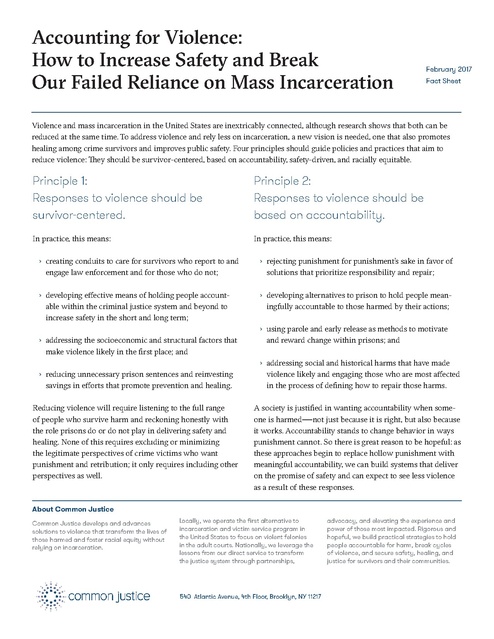Common Justice - Accounting for Violence Fact Sheet, 2017
Download original document:

Document text

Document text
This text is machine-read, and may contain errors. Check the original document to verify accuracy.
Accounting for Violence: How to Increase Safety and Break Our Failed Reliance on Mass Incarceration February 2017 Fact Sheet Violence and mass incarceration in the United States are inextricably connected, although research shows that both can be reduced at the same time. To address violence and rely less on incarceration, a new vision is needed, one that also promotes healing among crime survivors and improves public safety. Four principles should guide policies and practices that aim to reduce violence: They should be survivor-centered, based on accountability, safety-driven, and racially equitable. Principle 1: Responses to violence should be survivor-centered. Principle 2: Responses to violence should be based on accountability. In practice, this means: In practice, this means: ›› creating conduits to care for survivors who report to and engage law enforcement and for those who do not; ›› rejecting punishment for punishment’s sake in favor of solutions that prioritize responsibility and repair; ›› developing effective means of holding people accountable within the criminal justice system and beyond to increase safety in the short and long term; ›› developing alternatives to prison to hold people meaningfully accountable to those harmed by their actions; ›› addressing the socioeconomic and structural factors that make violence likely in the first place; and ›› reducing unnecessary prison sentences and reinvesting savings in efforts that promote prevention and healing. Reducing violence will require listening to the full range of people who survive harm and reckoning honestly with the role prisons do or do not play in delivering safety and healing. None of this requires excluding or minimizing the legitimate perspectives of crime victims who want punishment and retribution; it only requires including other perspectives as well. ›› using parole and early release as methods to motivate and reward change within prisons; and ›› addressing social and historical harms that have made violence likely and engaging those who are most affected in the process of defining how to repair those harms. A society is justified in wanting accountability when someone is harmed — not just because it is right, but also because it works. Accountability stands to change behavior in ways punishment cannot. So there is great reason to be hopeful: as these approaches begin to replace hollow punishment with meaningful accountability, we can build systems that deliver on the promise of safety and can expect to see less violence as a result of these responses. About Common Justice Common Justice develops and advances solutions to violence that transform the lives of those harmed and foster racial equity without relying on incarceration. Locally, we operate the first alternative to incarceration and victim service program in the United States to focus on violent felonies in the adult courts. Nationally, we leverage the lessons from our direct service to transform the justice system through partnerships, 540 Atlantic Avenue, 4th Floor, Brooklyn, NY 11217 advocacy, and elevating the experience and power of those most impacted. Rigorous and hopeful, we build practical strategies to hold people accountable for harm, break cycles of violence, and secure safety, healing, and justice for survivors and their communities. Principle 3: Responses to violence should be safety‑driven. Principle 4: Responses to violence should be racially equitable. In practice, this means: In practice, this means: ›› reckoning honestly with the limitations of incarceration to produce safety; ›› addressing the underlying and historical inequities that make violence likely in the first place; ›› developing a more nuanced understanding of the types of violence and the interventions that work to prevent and address them; ›› eliminating racial disparities in criminal justice decision making, from arrest to sentence to parole; ›› choosing the most effective interventions — even when they are not the most punitive; and ›› redirecting investments to strengthen the communitylevel infrastructure that helps prevent violence in the first place. Committing to a safety-driven response to violence means abandoning an overreliance on prison not simply because incarceration causes so much harm, but equally because it doesn’t deliver the outcomes everyone deserves. Committing to safety means committing to pragmatism rather than emotionality, to what works rather than what sells, and to outcomes rather than rhetoric. ›› holding people accountable equally, including system and law enforcement actors who cause serious harm; and ›› distributing resources for healing and recovery equally to survivors of all races and ethnicities. Any path to creating racial equity will reject extreme and disproportionate punishment — and will foster prevention efforts, community infrastructure, and the resources to help people heal and thrive. What is more, advancing racial equity is in itself a violence reduction strategy, as it has been widely documented that it is not simple poverty or lack of opportunity but inequity that drives crime and violence. We should therefore consider grappling with and repairing our history and present realities of racial oppression as a potentially transformative evidence-informed strategy to reduce violence. For more information © Vera Institute of Justice 2017. All rights reserved. The Vera Institute of Justice is a justice reform change agent. Vera produces ideas, analysis, and research that inspire change in the systems people rely upon for safety and justice, and works in close partnership with government and civic leaders to implement it. Vera is currently pursuing core priorities of ending the misuse of jails, transforming conditions of confinement, and ensuring that justice systems more effectively serve America’s increasingly diverse communities. 233 Broadway, 12th Floor, New York, NY 10279 To read this report, visit www.vera.org/ accounting-for-violence. For more information, contact Danielle Sered, director of Common Justice, at dsered@commonjustice.org. 212 334 1300 vera.org





